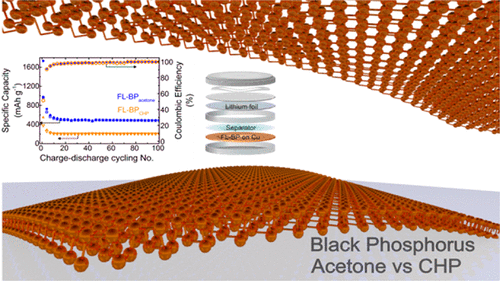当前位置:
X-MOL 学术
›
Chem. Mater.
›
论文详情
Our official English website, www.x-mol.net, welcomes your feedback! (Note: you will need to create a separate account there.)
Exfoliation of Few-Layer Black Phosphorus in Low-Boiling-Point Solvents and Its Application in Li-Ion Batteries
Chemistry of Materials ( IF 8.6 ) Pub Date : 2018-01-05 00:00:00 , DOI: 10.1021/acs.chemmater.7b04628 Antonio Esau Del Rio Castillo 1 , Vittorio Pellegrini 1 , Haiyan Sun 1 , Joka Buha 1 , Duc Anh Dinh 1 , Emanuele Lago 1 , Alberto Ansaldo 1 , Andrea Capasso 1 , Liberato Manna 1 , Francesco Bonaccorso 1
Chemistry of Materials ( IF 8.6 ) Pub Date : 2018-01-05 00:00:00 , DOI: 10.1021/acs.chemmater.7b04628 Antonio Esau Del Rio Castillo 1 , Vittorio Pellegrini 1 , Haiyan Sun 1 , Joka Buha 1 , Duc Anh Dinh 1 , Emanuele Lago 1 , Alberto Ansaldo 1 , Andrea Capasso 1 , Liberato Manna 1 , Francesco Bonaccorso 1
Affiliation

|
The liquid-phase exfoliation (LPE) of black phosphorus (BP) is a strategic route for the large-scale production of phosphorene and few-layer BP (FL-BP) flakes. The exploitation of this exfoliated material in cutting-edge technologies, e.g., in flexible electronics and energy storage, is however limited by the fact that the LPE of BP is usually carried out at a high boiling point and in toxic solvents. In fact, the solvent residual is detrimental to device performance in real applications; thus, complete solvent removal is critical. Here, we tackle these issues by exfoliating BP in different low-boiling-point solvents. Among these solvents, we find that acetone also provides a high concentration of exfoliated BP, leading to the production of FL-BP flakes with an average lateral size and thickness of ∼30 and ∼7 nm, respectively. The use of acetone to produce less defective few-layer BP flakes (FL-BPacetone) from bulk crystals is a straightforward process which enables the rapid preparation of homogeneous thin films thanks to the fast solvent evaporation. The ratio of edge to bulk atoms for the BP flakes here produced, combined with the use of low-boiling-point solvents for the exfoliation process, suggests that these thin films are promising anodes for lithium-ion batteries. To this end, we tested Li-ion half cells with FL-BPacetone anodes achieving a reversible specific capacity of 480 mA h g–1 at a current density of 100 mA g–1, over 100 charge/discharge cycles. Moreover, a reversible specific capacity of 345 mA h g–1 is achieved for the FL-BPacetone-based anode at high current density (i.e., 1 A g–1). These findings indicate that the FL-BPacetone-based battery is promising with regards to the design of fast charge/discharge devices. Overall, the presented process is a step forward toward the fabrication of phosphorene-based devices.
中文翻译:

低沸点溶剂中少层黑磷的剥落及其在锂离子电池中的应用
黑磷(BP)的液相剥落(LPE)是大规模生产phosphor和几层BP(FL-BP)薄片的战略途径。然而,这种剥离材料在尖端技术中(例如在柔性电子产品和能量存储中)的开发受到以下事实的限制:BP的LPE通常在高沸点和有毒溶剂中进行。实际上,残留溶剂对实际应用中的设备性能有害。因此,彻底去除溶剂至关重要。在这里,我们通过在不同的低沸点溶剂中剥离BP来解决这些问题。在这些溶剂中,我们发现丙酮还提供了高浓度的片状BP,导致生产出FL-BP薄片,其平均横向尺寸和厚度分别约为30和7 nm。块状晶体中的丙酮是一个简单的过程,由于溶剂的快速蒸发,可以快速制备均匀的薄膜。此处生产的BP薄片的边缘原子与本体原子之比,再加上在剥离过程中使用低沸点溶剂,表明这些薄膜是锂离子电池的有希望的阳极。为此,我们测试了使用FL-BP丙酮阳极的锂离子半电池,在100个充电/放电循环中,在100 mA g –1的电流密度下实现了480 mA hg –1的可逆比容量。此外,FL-BP丙酮的可逆比容量为345 mA hg –1电流密度高的阳极(即1 A g –1)。这些发现表明,基于FL-BP丙酮的电池在快速充电/放电设备的设计方面是有前途的。总体而言,提出的工艺是朝着制造基于磷光体的器件迈出的一步。
更新日期:2018-01-05
中文翻译:

低沸点溶剂中少层黑磷的剥落及其在锂离子电池中的应用
黑磷(BP)的液相剥落(LPE)是大规模生产phosphor和几层BP(FL-BP)薄片的战略途径。然而,这种剥离材料在尖端技术中(例如在柔性电子产品和能量存储中)的开发受到以下事实的限制:BP的LPE通常在高沸点和有毒溶剂中进行。实际上,残留溶剂对实际应用中的设备性能有害。因此,彻底去除溶剂至关重要。在这里,我们通过在不同的低沸点溶剂中剥离BP来解决这些问题。在这些溶剂中,我们发现丙酮还提供了高浓度的片状BP,导致生产出FL-BP薄片,其平均横向尺寸和厚度分别约为30和7 nm。块状晶体中的丙酮是一个简单的过程,由于溶剂的快速蒸发,可以快速制备均匀的薄膜。此处生产的BP薄片的边缘原子与本体原子之比,再加上在剥离过程中使用低沸点溶剂,表明这些薄膜是锂离子电池的有希望的阳极。为此,我们测试了使用FL-BP丙酮阳极的锂离子半电池,在100个充电/放电循环中,在100 mA g –1的电流密度下实现了480 mA hg –1的可逆比容量。此外,FL-BP丙酮的可逆比容量为345 mA hg –1电流密度高的阳极(即1 A g –1)。这些发现表明,基于FL-BP丙酮的电池在快速充电/放电设备的设计方面是有前途的。总体而言,提出的工艺是朝着制造基于磷光体的器件迈出的一步。


























 京公网安备 11010802027423号
京公网安备 11010802027423号